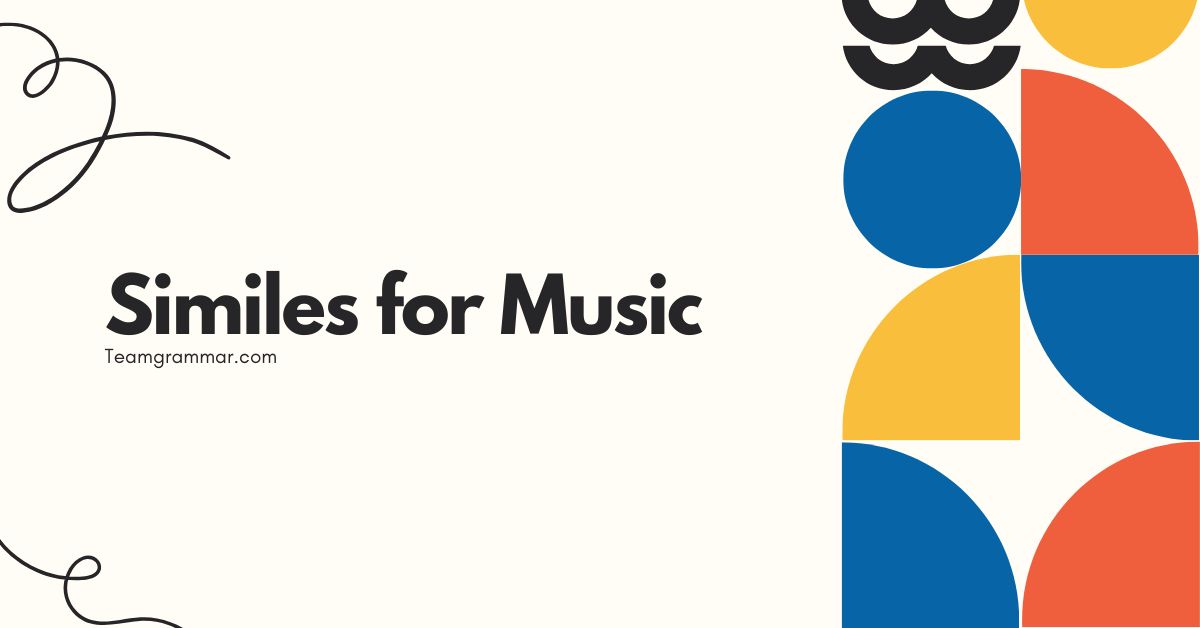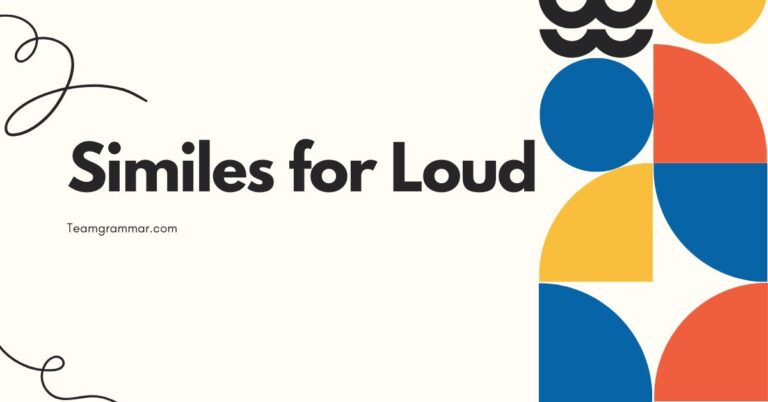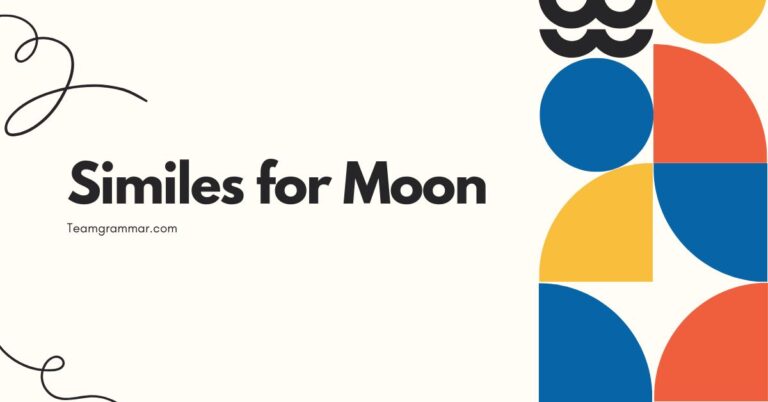49 Similes for Music: Enhancing Descriptions with Figurative Language
Music, an art form that transcends words, often requires equally evocative language to describe its nuances. Similes, comparisons using “like” or “as,” provide a powerful tool to capture the essence of musical experiences.
Understanding and employing similes effectively can transform mundane descriptions into vibrant, engaging narratives. This article delves into the world of similes used to describe music, exploring their structure, types, and applications.
Whether you’re a student, a music enthusiast, or a writer seeking to enrich your prose, this guide will equip you with the knowledge and skills to harness the descriptive power of similes in the context of music.
Table of Contents
- Definition of Similes
- Structural Breakdown of Similes
- Types of Similes
- Examples of Similes for Music
- Usage Rules for Similes
- Common Mistakes with Similes
- Practice Exercises
- Advanced Topics in Similes
- Frequently Asked Questions
- Conclusion
Definition of Similes
A simile is a figure of speech that directly compares two different things using the words “like” or “as.” It’s a tool used to make writing more vivid and imaginative by drawing a connection between something familiar and something less so. In the context of music, similes help listeners visualize and understand the qualities of a piece, performance, or musical element by relating it to something they already know.
Similes are a subset of figurative language, which includes metaphors, personification, and hyperbole. While a metaphor states that something *is* something else (e.g., “Music is a universal language”), a simile suggests that something is *like* something else (e.g., “The music flowed like a river”).
This distinction is crucial for understanding the subtle but significant difference in their effect on the reader or listener.
The function of a simile is to clarify, emphasize, or embellish a description. It allows writers and speakers to evoke specific images and sensations, making their descriptions more impactful and memorable.
In musical contexts, this might involve comparing a melody to birdsong, a rhythm to a heartbeat, or a harmony to a complex tapestry.
Structural Breakdown of Similes
Similes typically consist of three main components: the subject, the linking word, and the object of comparison. Thesubjectis the thing being described (in our case, a musical element).
Thelinking wordis either “like” or “as,” which establishes the comparison. Theobject of comparisonis the thing to which the subject is being compared.
For example, in the simile “The music was as smooth as silk,” the subject is “the music,” the linking word is “as,” and the object of comparison is “silk.” This structure clearly and concisely conveys the smoothness of the music by relating it to the tactile quality of silk.
The effectiveness of a simile depends on the relevance and clarity of the comparison. A good simile should create a vivid and understandable connection between the subject and the object.
An irrelevant or obscure comparison will only confuse the listener and detract from the description. Therefore, careful consideration should be given to the choice of the object of comparison.
Types of Similes
Similes can be categorized based on the type of comparison they make. This categorization can help in understanding how different types of similes can be used to describe various aspects of music.
Descriptive Similes
These similes focus on describing the qualities or characteristics of music. They aim to paint a picture of how the music sounds, feels, or makes one feel.
For example, “The melody was as bright as sunshine” describes the uplifting and cheerful quality of the melody.
Emotional Similes
Emotional similes connect music to specific emotions or feelings. They help convey the emotional impact of a piece of music on the listener.
An example is “The music felt like a warm embrace,” which conveys a sense of comfort and security.
Sensory Similes
Sensory similes appeal to the five senses – sight, sound, smell, taste, and touch – to describe music in a more tangible way. While sound is the primary sense associated with music, sensory similes can evoke other senses to create a richer and more immersive experience.
For instance, “The bass was as deep as a rumbling earthquake” uses the sense of touch and sound to describe the intensity of the bass.
Action-Oriented Similes
These similes describe the movement or action suggested by the music. They often involve verbs or dynamic imagery to convey the energy and flow of the music.
For example, “The notes danced like fireflies in the night” describes the lively and energetic movement of the notes.
Examples of Similes for Music
To illustrate the use of similes in describing music, here are several examples categorized by the aspect of music they describe. These examples showcase the variety and versatility of similes in capturing the essence of musical experiences.
Similes Describing Melody
Melody is the tune of a song, the sequence of notes that creates a recognizable musical phrase. Similes can capture the character of a melody, whether it’s soaring, gentle, or intricate.
The table below presents examples of similes that effectively describe the melody of a song or musical piece. Each simile aims to capture a specific aspect of the melody, such as its smoothness, complexity, or emotional impact.
| Simile | Explanation |
|---|---|
| The melody soared like an eagle in flight. | Describes a melody that is high-pitched and uplifting. |
| The melody was as smooth as silk. | Conveys a sense of fluidity and elegance. |
| The melody meandered like a gentle stream. | Suggests a calm and unhurried pace. |
| The melody was as intricate as a spider’s web. | Describes a complex and detailed melody. |
| The melody danced like fireflies on a summer night. | Conveys a sense of lightness and playfulness. |
| The melody crept in like a thief in the night. | Suggests a subtle, almost imperceptible entrance. |
| The melody unfolded like a blooming flower. | Conveys a sense of gradual and beautiful development. |
| The melody cascaded down like a waterfall. | Describes a melody with a descending and flowing quality. |
| The melody echoed like a distant memory. | Suggests a nostalgic and haunting quality. |
| The melody jumped and skipped like a playful child. | Conveys a sense of joy and energy. |
| The melody was as bright as a sunny morning. | Describes a cheerful and uplifting melody. |
| The melody was as haunting as a ghost story. | Conveys a sense of mystery and unease. |
| The melody flowed like honey. | Suggests a sweet and smooth quality. |
| The melody shimmered like heat on asphalt. | Conveys a sense of intensity and distortion. |
| The melody dripped like rain from eaves. | Describes a slow, melancholic melody. |
| The melody buzzed like a frantic bee. | Suggests a chaotic and unsettling feeling. |
| The melody purred like a contented cat. | Conveys a sense of peace and satisfaction. |
| The melody growled like a caged tiger. | Describes a powerful and restrained melody. |
| The melody sighed like a weary traveler. | Conveys a sense of exhaustion and longing. |
| The melody stuttered like an old record. | Suggests a broken or imperfect quality. |
| The melody was as clear as a mountain stream. | Describes a pure and pristine sound. |
| The melody was as complex as a mathematical equation. | Conveys a sense of intellectual rigor and challenge. |
| The melody was as fragile as a butterfly’s wing. | Suggests a delicate and easily damaged quality. |
Similes Describing Rhythm
Rhythm is the pattern of sounds and silences in music. Similes can capture the feel of a rhythm, whether it’s driving, syncopated, or steady.
The following table provides examples of similes that describe the rhythm of a musical piece. These similes use comparisons to familiar patterns and actions to convey the rhythmic feel.
| Simile | Explanation |
|---|---|
| The rhythm pounded like a drum in my chest. | Describes a strong and forceful rhythm. |
| The rhythm flowed like a heartbeat. | Conveys a sense of natural and steady pulse. |
| The rhythm was as erratic as a hummingbird’s wings. | Suggests an unpredictable and rapid pattern. |
| The rhythm marched forward like soldiers in formation. | Describes a disciplined and uniform rhythm. |
| The rhythm skipped like a stone across water. | Conveys a sense of lightness and irregularity. |
| The rhythm pulsed like neon lights. | Suggests a vibrant and energetic pulse. |
| The rhythm chugged like a steam engine. | Describes a steady and powerful rhythmic drive. |
| The rhythm swayed like palm trees in the breeze. | Conveys a relaxed and fluid rhythm. |
| The rhythm stuttered like a broken record. | Suggests an interrupted or uneven rhythm. |
| The rhythm galloped like a wild horse. | Describes a fast and unrestrained rhythm. |
| The rhythm was as steady as a ticking clock. | Conveys a sense of reliability and consistency. |
| The rhythm was as complex as a jazz improvisation. | Suggests a rich and intricate rhythmic texture. |
| The rhythm hit like a boxer’s punch. | Describes a sharp and impactful rhythm. |
| The rhythm crept in like a shadow. | Conveys a subtle and gradual rhythmic change. |
| The rhythm buzzed like a swarm of bees. | Suggests a busy and chaotic rhythmic texture. |
| The rhythm crunched like gravel underfoot. | Describes a rough and abrasive rhythmic sound. |
| The rhythm dripped like water from a leaky faucet. | Conveys a slow and repetitive rhythmic pattern. |
| The rhythm exploded like a fireworks display. | Suggests a sudden and spectacular rhythmic burst. |
| The rhythm floated like a feather in the wind. | Describes a light and airy rhythmic feel. |
| The rhythm growled like a distant thunder. | Conveys a deep and ominous rhythmic presence. |
| The rhythm was as persistent as a dripping tap. | Describes a continuous and unrelenting pulse. |
| The rhythm was as unpredictable as a dice roll. | Suggests a random and chaotic rhythmic pattern. |
| The rhythm was as tight as a coiled spring. | Conveys a sense of tension and anticipation. |
Similes Describing Harmony
Harmony is the combination of musical notes sounded simultaneously to produce chords and chord progressions. Similes can describe the richness, complexity, and emotional impact of harmonies.
The table below contains examples of similes used to describe the harmony in music. These similes often relate the harmony to visual or tactile sensations, making the abstract concept more accessible.
| Simile | Explanation |
|---|---|
| The harmonies blended like colors in a painting. | Describes a smooth and cohesive harmonic texture. |
| The harmonies clashed like thunder. | Conveys a sense of dissonance and tension. |
| The harmonies were as rich as velvet. | Suggests a luxurious and full harmonic sound. |
| The harmonies shimmered like stars in the night sky. | Describes a bright and ethereal harmonic quality. |
| The harmonies were as dissonant as nails on a chalkboard. | Conveys a sense of unease and discomfort. |
| The harmonies intertwined like vines on a trellis. | Suggests a complex and interconnected harmonic structure. |
| The harmonies were as sweet as honey. | Describes a pleasant and harmonious sound. |
| The harmonies unfolded like a story. | Conveys a sense of narrative and development. |
| The harmonies were as warm as a fireplace. | Suggests a comforting and inviting harmonic sound. |
| The harmonies crumbled like old ruins. | Describes a decaying or unstable harmonic structure. |
| The harmonies were as cold as ice. | Conveys a sense of detachment and austerity. |
| The harmonies built up like a storm. | Suggests a gradual increase in intensity and tension. |
| The harmonies were as thick as molasses. | Describes a dense and heavy harmonic texture. |
| The harmonies danced like spirits in the air. | Conveys a sense of lightness and freedom. |
| The harmonies were as sharp as a knife. | Suggests a cutting and incisive harmonic sound. |
| The harmonies were as round as a full moon. | Describes a full and resonant harmonic quality. |
| The harmonies were as transparent as glass. | Conveys a clear and uncluttered harmonic texture. |
| The harmonies were as mysterious as a hidden treasure. | Suggests a sense of intrigue and discovery. |
| The harmonies were as smooth as butter. | Describes a seamless and flowing harmonic progression. |
| The harmonies were as vibrant as a rainbow. | Conveys a colorful and lively harmonic palette. |
Similes Describing Dynamics
Dynamics refer to the loudness or softness of music. Similes can capture the changes and contrasts in dynamics, from the quietest whisper to the loudest roar.
The following table provides examples of similes that describe the dynamics of a musical piece. These similes use comparisons to changes in weather or natural phenomena to illustrate the intensity of the music.
| Simile | Explanation |
|---|---|
| The music swelled like a rising tide. | Describes a gradual increase in volume. |
| The music faded like a dying ember. | Conveys a gradual decrease in volume. |
| The music exploded like a supernova. | Suggests a sudden and dramatic increase in volume. |
| The music whispered like a secret. | Describes a very quiet and intimate sound. |
| The music roared like a hurricane. | Conveys a loud and powerful sound. |
| The dynamics fluctuated like the stock market. | Suggests unpredictable changes in volume. |
| The music pulsed like a heartbeat, growing louder and softer. | Describes a rhythmic change in dynamics. |
| The dynamics were as subtle as a feather falling. | Conveys a delicate and barely perceptible change in volume. |
| The music crashed like waves on the shore. | Suggests a loud and forceful dynamic. |
| The dynamics ebbed and flowed like the breath. | Describes a natural and rhythmic change in volume. |
| The music thundered like a waterfall. | Conveys a powerful and overwhelming dynamic level. |
| The dynamics were as gentle as a lullaby. | Suggests a soft and soothing volume. |
| The music boomed like a cannon. | Describes a loud and impactful sound. |
| The dynamics were as sharp as a whip crack. | Conveys a sudden and intense dynamic change. |
| The music drifted like smoke, sometimes present, sometimes gone. | Suggests a fluctuating and ethereal dynamic level. |
Usage Rules for Similes
While similes are a creative tool, there are certain rules to consider for effective use. These rules ensure that the simile is clear, relevant, and impactful.
Clarity
The comparison should be easily understood. Avoid obscure or overly complex comparisons that might confuse the listener.
The object of comparison should be something familiar to the audience.
Relevance
The comparison should be relevant to the aspect of music being described. The qualities being compared should be similar or related.
For example, comparing the smoothness of a melody to the smoothness of silk is a relevant comparison because both involve a sense of fluidity and ease.
Originality
While common similes can be effective, striving for originality can make your writing more engaging. Avoid clichés and try to find fresh and unique comparisons.
Instead of saying “the music was as loud as thunder,” try “the music roared like a spaceship taking off.”
Context
Consider the context in which the simile is being used. The simile should be appropriate for the tone and style of the writing.
A formal analysis of classical music might require more sophisticated similes than a casual review of a pop song.
Common Mistakes with Similes
Even with a good understanding of similes, it’s easy to make mistakes. Here are some common errors to avoid:
Using Clichés
Clichés are overused similes that have lost their impact. Examples include “as light as a feather” or “as quiet as a mouse.” While they are easy to use, they often lack originality and fail to create a vivid image.
Incorrect: The music was as light as a feather.
Correct: The music floated like dandelion seeds on a breeze.
Irrelevant Comparisons
An irrelevant comparison can confuse the listener and detract from the description. The object of comparison should have a clear and logical connection to the subject.
Incorrect: The melody was as blue as a car.
Correct: The melody was as blue as a mournful ballad.
Overly Complex Similes
While originality is important, avoid making the simile too complex or convoluted. The comparison should be easy to understand and visualize.
Incorrect: The harmony was like a fractal pattern of interconnected emotional resonances, echoing through the chambers of the soul.
Correct: The harmony was as intricate as a cathedral’s stained glass.
Misusing “Like” and “As”
Ensure that “like” and “as” are used correctly to form a simile. “Like” is a preposition, while “as” can be used as a conjunction or adverb in similes.
Incorrect: The music was smooth as it was silk.
Correct: The music was as smooth as silk.
Practice Exercises
To solidify your understanding of similes for music, here are some practice exercises. Each exercise focuses on a different aspect of using similes effectively.
Exercise 1: Identifying Similes
Identify the similes in the following sentences.
| Question | Answer |
|---|---|
| 1. The music was as vibrant as a tropical sunset. | as vibrant as a tropical sunset |
| 2. The rhythm pounded like a drum in my chest. | like a drum in my chest |
| 3. The melody flowed, creating a peaceful atmosphere. | No simile present |
| 4. The harmonies blended like colors in a painting. | like colors in a painting |
| 5. Her voice is music to my ears. | No simile present (this is a metaphor) |
| 6. The notes danced like fireflies on a summer night. | like fireflies on a summer night |
| 7. The bass was as deep as a rumbling earthquake. | as deep as a rumbling earthquake |
| 8. The song was a journey through sound. | No simile present (this is a metaphor) |
| 9. The music swelled like a rising tide. | like a rising tide |
| 10. His guitar playing is legendary. | No simile present |
Exercise 2: Completing Similes
Complete the following similes with an appropriate comparison.
| Question | Answer |
|---|---|
| 1. The melody was as sweet as _____. | The melody was as sweet as honey. |
| 2. The rhythm was as steady as _____. | The rhythm was as steady as a heartbeat. |
| 3. The harmonies were as rich as _____. | The harmonies were as rich as velvet. |
| 4. The dynamics were as gentle as _____. | The dynamics were as gentle as a whisper. |
| 5. The music flowed like _____. | The music flowed like a river. |
| 6. The singer’s voice soared like _____. | The singer’s voice soared like an eagle. |
| 7. The guitar solo screamed like _____. | The guitar solo screamed like a banshee. |
| 8. The drums pounded like _____. | The drums pounded like thunder. |
| 9. The piano keys twinkled like _____. | The piano keys twinkled like stars. |
| 10. The music felt like _____. | The music felt like a warm embrace. |
Exercise 3: Writing Similes
Write a simile to describe each of the following aspects of music.
| Aspect of Music | Example Answer |
|---|---|
| 1. A fast tempo | The tempo raced like a cheetah chasing its prey. |
| 2. A complex arrangement | The arrangement was as intricate as a clock’s inner workings. |
| 3. A powerful vocal performance | Her voice hit me like a tidal wave. |
| 4. A melancholic melody | The melody was as sad as a rainy day. |
| 5. A vibrant musical texture | The music was as colorful as a peacock’s feathers. |
| 6. The way a song builds to a climax | The song built up like a volcano about to erupt. |
| 7. A repetitive musical phrase | The musical phrase was as tireless as a metronome. |
| 8. A sudden, unexpected chord change | The chord change hit like a sudden cold shower. |
| 9. The feeling of resolution at the end of a song | The ending felt like finally arriving home after a long journey. |
| 10. A song that makes you want to dance | The song made me want to dance like nobody was watching. |
Advanced Topics in Similes
For advanced learners, exploring the nuances and subtleties of similes can further enhance their writing and analytical skills.
Extended Similes
An extended simile is a simile that is developed over several sentences or paragraphs. It allows for a more detailed and nuanced comparison, creating a richer and more immersive experience for the reader.
Implied Similes
An implied simile is a simile that does not explicitly use “like” or “as.” Instead, the comparison is suggested through the use of vivid imagery and descriptive language.
Subverted Similes
A subverted simile is a simile that intentionally defies expectations or clichés. It can be used to create humor, irony, or a sense of surprise.
Frequently Asked Questions
- What is the difference between a simile and a metaphor?
A simile compares two things using “like” or “as,” while a metaphor directly equates them without using these words. For instance, “The music is like a river” (simile) versus “The music is a river” (metaphor). Similes suggest similarity, while metaphors assert identity.
- How can I avoid using clichés in my similes?
To avoid clichés, brainstorm unique and specific comparisons. Instead of “as loud as thunder,” consider “as loud as a jet engine.” Think about the specific qualities you want to convey and find fresh ways to express them.
- What makes a simile effective?
An effective simile is clear, relevant, and original. It should create a vivid image in the reader’s mind and enhance their understanding of the subject being described. The comparison should be logical and easy to grasp.
- Can similes be used in formal writing?
Yes, similes can be used in formal writing, but they should be used sparingly and with careful consideration. The simile should be appropriate for the tone and style of the writing, and it should enhance the clarity and impact of the description.
- How can I improve my ability to write effective similes?
Practice is key. Read widely and pay attention to how other writers use similes. Experiment with different comparisons and ask for feedback on your writing. The more you practice, the better you will become at crafting effective similes.
- Are there any types of music where similes are more commonly used?
Similes can be used to describe any type of music. However, they may be particularly useful in describing genres that are highly evocative or emotional, such as classical music, blues, or film scores.
- How do you choose the right object of comparison for a simile?
Consider the qualities you want to emphasize about the music. Is it smooth, rough, loud, quiet, complex, or simple? Choose an object of comparison that shares those qualities and is easily recognizable to your audience. For example, if you want to describe the smoothness of a melody, you might compare it to silk or velvet.
- What is an implied simile, and how is it different from a regular simile?
An implied simile suggests a comparison without explicitly using “like” or “as.” For example, instead of saying “The music was *like* a warm blanket,” you might say “The music enveloped me in warmth,” implying the comparison without direct use of the linking words.
- Can a simile be too descriptive?
Yes, a simile can be too descriptive if it becomes overly complex or convoluted, obscuring the main point rather than clarifying it. Keep the comparison concise and focused on the most relevant qualities.
- How important is cultural context when using similes?
Cultural context is crucial. A simile that resonates with one audience may be confusing or meaningless to another. Choose comparisons that are familiar and relevant to your intended audience to ensure clarity and impact.
Conclusion
Similes offer a powerful way to describe music, transforming abstract sounds into tangible experiences. By understanding the structure, types, and usage rules of similes, you can enhance your writing and analytical skills, creating vivid and engaging descriptions of musical elements.
Avoiding common mistakes like clichés and irrelevant comparisons will further refine your ability to craft effective similes.
Practice is essential for mastering the art of using similes. Experiment with different comparisons, seek feedback on your writing, and continue to explore the rich possibilities of figurative language.
With dedication and attention to detail, you can unlock the descriptive power of similes and elevate your understanding and appreciation of music.







